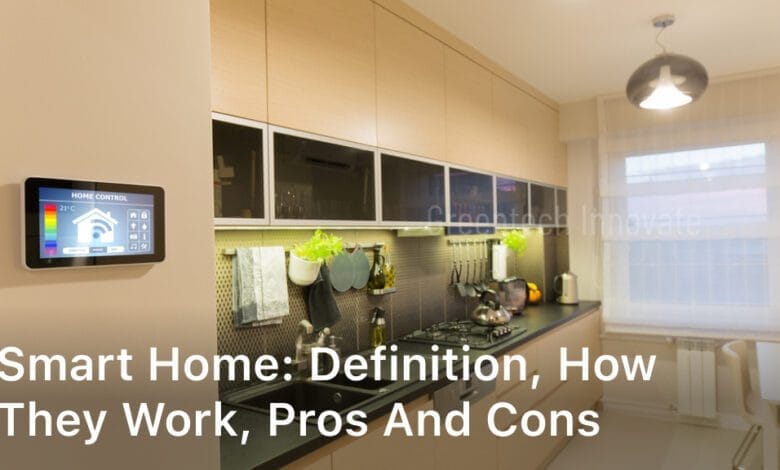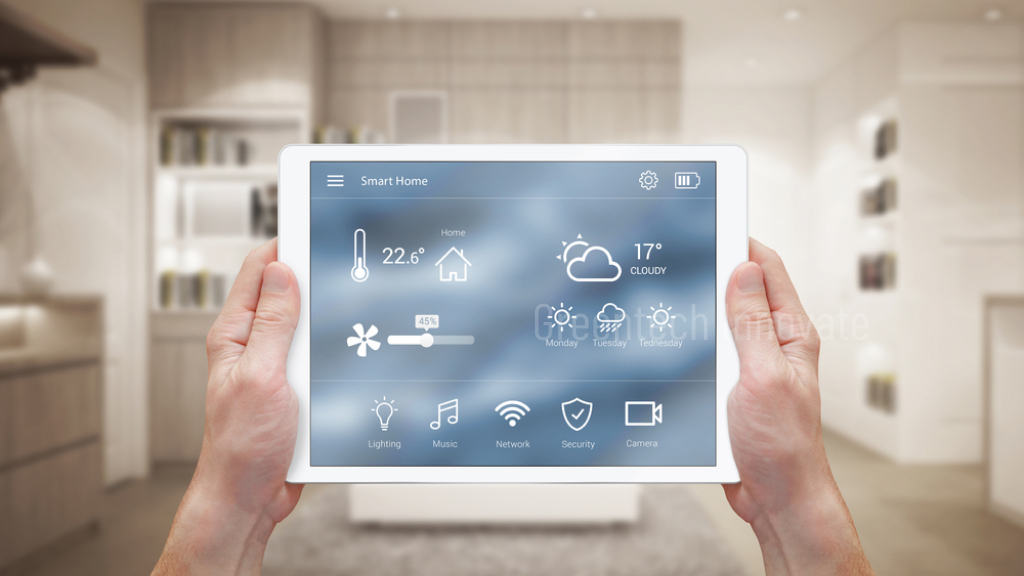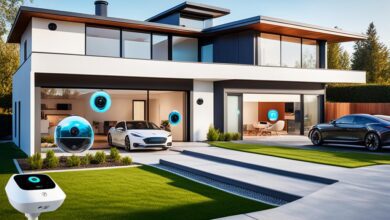
Welcome to our comprehensive guide on Smart Homes. In this article, we will explore the fascinating world of Smart Home technology, including what it is, how it works, and the pros and cons of embracing this innovative way of living. Whether you’re a tech enthusiast or simply looking to make your daily life more convenient and efficient, understanding the ins and outs of Smart Homes is essential.
What is a Smart Home?
A Smart Home is a residential space that incorporates advanced technology to enhance the functionality and automation of various aspects of the home. It is equipped with interconnected devices and systems that can communicate with each other and be controlled remotely, offering homeowners a new level of convenience, efficiency, and comfort.
At its core, a Smart Home utilizes the Internet of Things (IoT) technology, enabling devices and appliances to connect and interact with each other through a common network. This allows homeowners to control and manage different aspects of their home, such as lighting, heating, security, entertainment systems, and more, using their smartphones, tablets, or voice commands.
With the integration of sensors, cameras, voice recognition systems, and artificial intelligence, a Smart Home can learn from the occupants’ habits and preferences, making adjustments and automating tasks to create personalized and efficient living spaces.
By embracing this cutting-edge technology, homeowners can enjoy a myriad of benefits, including improved energy efficiency, enhanced security and surveillance, simplified home management, increased comfort and convenience, and even potential cost savings over time.
In the next section, we will explore in detail how Smart Homes work, shedding light on the key technologies and devices that enable this seamless integration of technology within the home environment.
How Do Smart Homes Work?

In this section, we will explore the inner workings of a Smart Home and discover the technologies and devices that make it possible. Smart Homes are designed to enhance convenience, security, energy efficiency, and overall comfort within the home environment. Let’s take a closer look at the key components that enable Smart Homes to function seamlessly.
Sensors and Devices
Smart Homes rely on a network of sensors and devices to collect data and interact with the environment. These devices can include motion sensors, temperature sensors, door and window sensors, and cameras. They work together to provide real-time information and enable automation based on specific triggers or conditions.
Connectivity
Connectivity is crucial in a Smart Home system. Devices communicate with each other and with the homeowner through a central hub or a home automation platform. This allows for seamless integration and remote control of various aspects of the home, such as lighting, thermostats, security systems, and entertainment systems.
Home Automation Platforms
Home automation platforms serve as the brain of a Smart Home. These platforms, such as Amazon Alexa, Google Home, or Apple HomeKit, enable users to control and manage their Smart Home devices using voice commands or mobile apps. They provide a centralized interface for monitoring and controlling different systems in the home.
Data Analysis and Machine Learning
Data analysis and machine learning play a significant role in Smart Homes. The collected data from various sensors and devices is analyzed to develop patterns and make intelligent predictions. Machine learning algorithms can recognize behavioral patterns, adjust settings automatically, and offer personalized experiences to homeowners.
Integration with Internet of Things (IoT)
A Smart Home is part of the larger Internet of Things (IoT) ecosystem, where devices and systems are interconnected to share information and provide seamless functionality. Integrating with IoT allows Smart Homes to access a wide range of services, such as weather updates, energy management, and home security.
| Key Components | Function |
|---|---|
| Sensors and Devices | Collect data and trigger automation |
| Connectivity | Enable communication between devices |
| Home Automation Platforms | Central control and management |
| Data Analysis and Machine Learning | Identify patterns and provide personalized experiences |
| Integration with Internet of Things (IoT) | Access additional services and functionalities |
Pros and Cons of Smart Homes
As with any technological advancement, Smart Homes come with their fair share of advantages and disadvantages. It is important for individuals to carefully evaluate the pros and cons before embracing this innovative technology.
The Pros of Smart Homes:
- Convenience: Smart Homes offer a higher level of convenience by allowing homeowners to control various aspects of their homes remotely. This includes adjusting the temperature, turning on/off lights, and even managing home security systems, all at the touch of a button.
- Energy Efficiency: By integrating smart devices and systems, Smart Homes can help reduce energy consumption. Automated thermostats, smart lighting, and energy monitoring systems enable homeowners to optimize energy usage, resulting in potential cost savings and reduced environmental impact.
- Improved Security: Smart Home technology provides homeowners with enhanced security features such as remote monitoring, surveillance cameras, and smart locks. These features offer peace of mind by allowing homeowners to keep a watchful eye on their property, deterring potential intruders, and promptly responding to security threats.
- Enhanced Comfort: Smart Homes can create a more comfortable living environment by automating tasks and adjusting settings to suit individual preferences. From adjusting the lighting to creating personalized temperature zones, Smart Homes adapt to homeowners’ needs, ensuring optimal comfort throughout the day.
The Cons of Smart Homes:
- Privacy Concerns: With the integration of smart devices and data sharing, privacy concerns can arise. Smart Home systems collect and analyze personal data, raising questions about the security and privacy of this information.
- Initial Cost Investments: Implementing Smart Home technology requires an initial financial investment. The cost of purchasing smart devices, installation, and potential professional assistance to set up the system can be substantial.
- Compatibility Issues: The compatibility between different Smart Home devices and systems may pose challenges. Homeowners need to ensure that the devices they choose are compatible with their existing systems, preventing potential issues with connectivity and integration.
- Reliance on Technology: Smart Home systems heavily rely on technology, and in the event of a power outage or technical malfunction, homeowners may face disruptions in their daily routines and functions.
By understanding the pros and cons of Smart Homes, individuals can make informed decisions about adopting this technology. It is crucial to weigh the benefits against the potential drawbacks to determine if Smart Home technology aligns with individual needs and preferences.
Exploring the Benefits of Smart Homes
Smart Homes offer a myriad of benefits that can significantly enhance your daily life. By integrating advanced technologies, these automated homes provide convenience, energy efficiency, improved security, and enhanced comfort. Let’s delve into these advantages to understand why Smart Homes are gaining popularity.
1. Increased Convenience
One of the most significant benefits of a Smart Home is the convenience it brings to your everyday routine. With automated systems and intelligent devices, you can control various aspects of your home from a single interface, such as adjusting the temperature, turning on lights, or even operating appliances. Voice-controlled assistants like Amazon Alexa or Google Assistant enable easy and effortless control, making your life more convenient and efficient.
2. Energy Efficiency
Smart Homes are designed to optimize energy consumption, leading to significant savings on utility bills. Automated thermostats can learn your preferred temperature settings and adjust heating and cooling accordingly, ensuring energy is not wasted when you’re not at home. Additionally, smart lighting systems can automatically turn lights on and off based on occupancy or time of day, reducing energy waste and contributing to a greener environment.
3. Improved Security
Security is a top priority for homeowners, and Smart Homes offer advanced security features for peace of mind. With smart door locks, surveillance cameras, and motion sensors, you can monitor your home remotely and receive notifications of any suspicious activity. Integration with smartphone apps allows you to control and monitor your security system from anywhere, giving you complete control over the safety of your home and loved ones.
4. Enhanced Comfort
Smart Home technology enhances the comfort of your living spaces with features like automated window coverings, smart thermostats, and personalized lighting. You can set the perfect ambiance for different activities, whether it’s a cozy movie night or a vibrant dinner party. Imagine waking up to natural sunlight streaming in through automated blinds or arriving home to a perfectly temperature-controlled environment—these small touches greatly enhance the comfort of your home.
Comparing Benefits of Smart Homes
| Benefits | Smart Home | Traditional Home |
|---|---|---|
| Convenience | Centralized control of various functions | Manual operation of individual devices |
| Energy Efficiency | Optimized energy consumption | Higher energy wastage |
| Improved Security | Remote access and surveillance | Traditional alarm systems |
| Enhanced Comfort | Customizable ambiance and settings | Limited control over environment |
As seen in the table above, Smart Homes provide significant advantages compared to traditional homes. With increased convenience, energy efficiency, improved security, and enhanced comfort, embracing Smart Home technology can transform the way you live.
Understanding the Drawbacks of Smart Homes
While Smart Homes offer numerous benefits, it is essential to understand the potential drawbacks that come with this advanced technology. By exploring these concerns, potential homeowners can make informed decisions about whether or not to adopt Smart Home systems.
Privacy Concerns
One of the primary concerns associated with Smart Homes revolves around privacy. As these systems rely on data collection and connectivity, there is an inherent risk of unauthorized access and potential breaches. Homeowners must carefully consider the privacy implications of having various devices interconnected within their living spaces.
Initial Cost Investments
An important factor to consider when contemplating a Smart Home is the initial cost investment required. The installation of smart devices, sensors, and automation systems can be expensive. Homeowners should weigh the potential long-term savings against the upfront costs to determine if the investment aligns with their personal financial goals.
Compatibility Issues
Another drawback of Smart Homes is the potential for compatibility issues. With different manufacturers and technologies, there may arise difficulties in integrating devices seamlessly. Homeowners must ensure that the chosen devices and systems are compatible with one another to avoid frustration and inconvenience.
Reliance on Technology
While Smart Homes offer increased convenience and automation, they also come with a reliance on technology. If the systems or devices encounter technical glitches or malfunctions, it can disrupt the normal functioning of a home. Homeowners should be prepared for potential system failures and have backup plans in place.
By understanding these drawbacks, potential Smart Home adopters can make an informed decision that aligns with their needs and lifestyle.
| Drawback | Description |
|---|---|
| Privacy Concerns | Smart Homes introduce potential privacy risks due to data collection and connectivity. |
| Initial Cost Investments | The installation of Smart Home systems can involve significant upfront costs. |
| Compatibility Issues | Different manufacturers and technologies may lead to compatibility problems between devices. |
| Reliance on Technology | Smart Homes require a dependence on technology, with the potential for disruptions and malfunctions. |
Conclusion
After exploring the world of Smart Homes, it is clear that this technology offers numerous benefits and conveniences for homeowners. A Smart Home is defined as a residential space equipped with interconnected devices and systems that enhance automation and control.
By leveraging technologies like artificial intelligence (AI), internet of things (IoT), and voice assistants, Smart Homes can facilitate efficient energy management, improve security measures, and streamline day-to-day tasks. Homeowners can enjoy features such as remote access, voice-controlled devices, and customized settings tailored to their preferences.
However, it is important to consider the potential drawbacks of Smart Homes as well. These may include the initial cost of investment, compatibility issues between different devices, and privacy concerns. It is crucial for homeowners to carefully evaluate these factors and ensure the chosen Smart Home system aligns with their needs and preferences.
In conclusion, Smart Homes offer a remarkable blend of innovation and convenience. They have the potential to revolutionize our living spaces by providing greater comfort, security, and efficiency. As this technology continues to evolve, homeowners should weigh the advantages and disadvantages before fully embracing the Smart Home experience.
FAQ
What is a Smart Home?
A Smart Home refers to a residential space that integrates various technologies to enhance its functionality and automation. By connecting different devices and appliances, a Smart Home enables homeowners to control and monitor their home remotely, creating a more convenient and efficient living environment.
How do Smart Homes work?
Smart Homes utilize a network of interconnected devices and sensors that communicate with each other through wireless protocols. These devices, including smart thermostats, lighting systems, security cameras, and voice assistants, are controlled through a central hub or smartphone application. By leveraging internet connectivity, Smart Homes offer remote access and automated control over various aspects of the home, such as temperature, lighting, security, and entertainment.
What are the pros and cons of Smart Homes?
Smart Homes offer numerous benefits, such as increased convenience, energy efficiency, improved security, and enhanced comfort. They can simplify daily tasks, save energy, provide advanced security features, and offer personalized experiences. However, there are potential drawbacks to consider, including privacy concerns, initial cost investments, compatibility issues, and reliance on technology.
What are the benefits of Smart Homes?
Smart Homes provide several advantages. They allow homeowners to control devices remotely, automate routine tasks, and create personalized settings. Smart Home technology can help save energy by optimizing heating, cooling, and lighting systems. It also enhances security through features like smart locks and surveillance cameras. Additionally, Smart Homes offer convenience and comfort by integrating devices and providing seamless connectivity.
What are the drawbacks of Smart Homes?
While Smart Homes offer various benefits, there are potential downsides to consider. Privacy concerns are one aspect, as Smart Home devices collect and store user data. Initial costs can be high, especially when retrofitting an existing home with Smart technology. Compatibility issues may arise when integrating devices from different manufacturers. Lastly, there is a level of reliance on technology, which may be a challenge if technological issues occur or in the event of a power outage.




